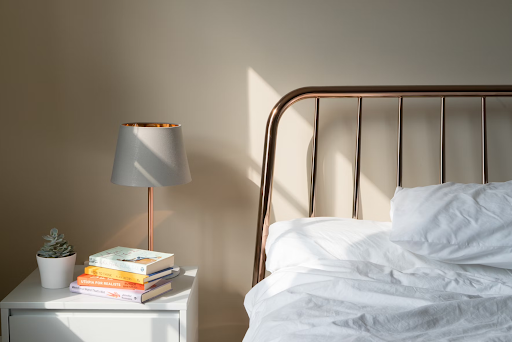Why Hay Fever Is Worse at Night

Author: Jonathan Warren
Hay Fever and Allergies at Night: Why Symptoms Are Heightened and How to Deal with Them
For most of us the sight of flowering trees, long evenings and warmer temperatures are ones to look forward. Spring and summer bring many benefits but for some, there is a cost. For hay fever sufferers, it can also mean sleepless nights full of eye-itching and sneezing.
For many, hay fever or similar allergies are at their worst when the sun goes down at night. Here, we’ll explain why hay fever symptoms can be worse at night, plus give you a few solutions for sleeping better with allergies.
Why hay fever and allergies are worse at night
Logic suggests that during the day, your exposure to pollen is going to be greater. Likely to be out the house, you’ll come closer to flowers, cut grass and other objects carrying pollen. Yet for some, the common symptoms of hay fever and allergies come when you’re tucked up in bed, seemingly safe from all those dangers.
There is an explanation for this. In fact, it could be one of two things:
Pollen showers
Pollen is pretty small. The smallest pollen grain (that of the forget-me-not) get to around 0.006 mm in diameter. As a result, they don’t weigh a lot. When the sun is out, hot air rises and carries pollen away with it. When the air cools again at night, the pollen falls back down to the earth again. This is the process that is giving you hay fever at night.
It’s worth considering when your symptoms kick in, as there might be an explanation for that too. In rural areas where there is plenty of greenery, this process will happen before midnight. In city centres or built-up areas with lots of concrete, the area stays hotter for longer. This delays the process by a couple of hours until after midnight.
Do you find yourself waking up at a particular time each night, and does that match with the type of area you live in? If so, it might be the above phenomenon that’s impacting your night’s sleep.
Hay fever or allergic rhinitis?
If you find the same symptoms flaring up when the colder autumn and winter months set in, it’s probably not hay fever at all. Chances are you’re allergic to something else and suffer from allergic rhinitis.
According to the NHS, allergic rhinitis is:
Allergic rhinitis is inflammation of the inside of the nose caused by an allergen, such as pollen, dust, mould or flakes of skin from certain animals.
It affects one in five people and comes with all the same symptoms you’d expect from hay fever: sneezing, itchy eyes and a runny nose. This is why it’s so easily confused with hay fever.
6 solutions to sleeping better with allergies
It may be the case that you’re allergic to something in your bedroom. Be it dust mites, mould spores or just skin cells, if they get in your nose, they could cause allergic rhinitis. No matter if it’s hay fever or another allergy, there are steps you can take to put an end to your miserable evenings.
Here are no less than six steps that could help you.
1. Change up your shower routine
As you go about your day, you’re slowing accumulating dust and pollen in your hair, clothes and on your skin. Once you get home and in bed, they can become irritable to your eyes and nose.
Cleanse yourself of these allergens by jumping in the shower at night rather in the morning (or in addition to first thing). It’ll wash all that pesky dust from your skin and with clean clothes you’ll be feeling fresh once you get into bed. Plus, that hot steam can help with any blocked noses.
2. Keep your pillows and sheets clean
As you go in and out of your room, opening doors and windows along the way, you invite allergens into your room and onto your bedding. You can minimise the impact of this as much as possible with regular washing. It’s also best not to buy certain materials such as wool or feathers, as they can’t be washed regularly. As a result, they will gather more dust and mites than synthetics.
3. Consider hypoallergenic bedding
As a level up from point two, you could invest in bedding specifically developed to protect those with allergies. Hypoallergenic bedding is made from material which is resistant to allergens. Memory foam is one example of a hypoallergenic material. Cotton is a natural hypoallergenic too.
It could benefit you in many ways. First, it will stop the collecting of allergens on your pillows and duvets, keeping you feeling fresh at night. Elsewhere, a mattress topper can put a layer of protection between you and your mattress, protecting it from allergens that are harder to clean off.
4. Keep your air clean
The warm, moist summer air is a happy breeding ground for bacteria, dust mites and mould – all of which are allergens that could keep you awake at night. Try to keep the air in the bedroom as clean as possible using one, or a combination, of these things.
Try a dehumidifier or air purifier to keep your humidity down on sweaty days, sucking moisture out of the air. Alternatively, you keep a few air-purifying plants such as a peace lily or rubber plant.
On top of these, make regular checks of your windows for cracks in the sealant, which would allow pollen and dust to creep inside.
5. Keep pets away from the bedroom
Whilst not all dogs are allergenic, most are. Their hair can not only cause itching and irritation to your skin and face, but it also carries lots of the allergens that can then be transferred into the home.
It’s all too tempting to let them into the bed for a night-time cuddle. If you do suffer from hay fever or allergens, it really isn’t recommended.



